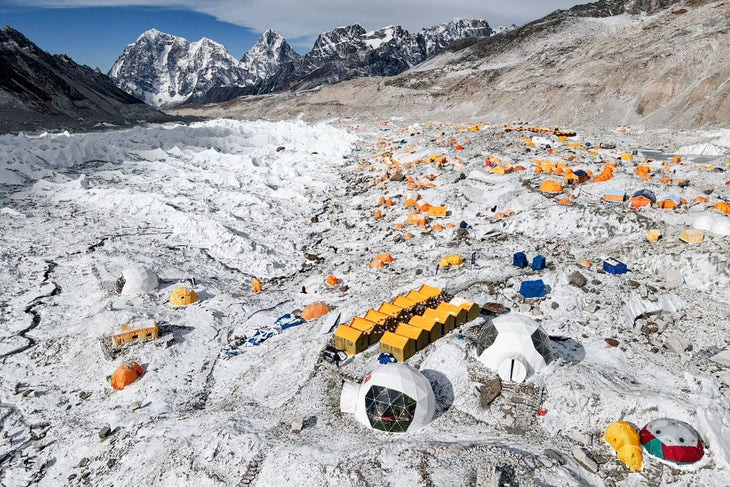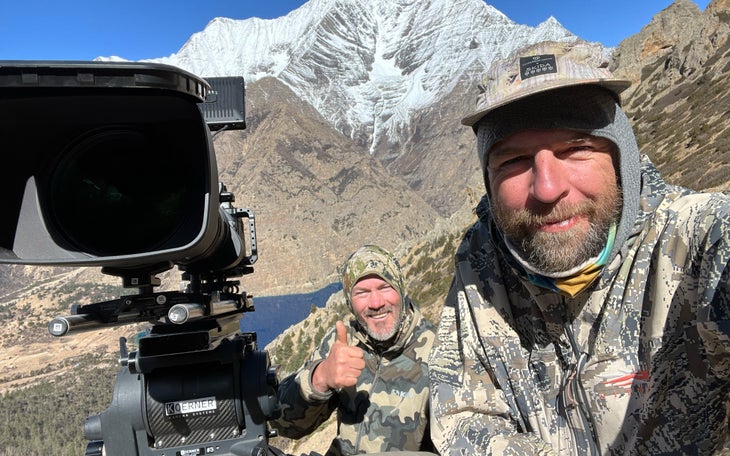
During the spring climbing season, the lobby of the Aloft Hotel in the Thamel district of Kathmandu becomes the de-facto brain center of Nepal’s high-altitude mountaineering industry.
Several of Nepal’s largest guiding companies book rooms for their clients and foreign guides at the hotel before they travel to Mount Everest Base Camp. The owners of these companies often hold meetings around hightop tables in the hotel’s lobby.
The hotel lobby was unremarkable when I visited on Sunday, April 13, except for a pyramid of rugged yellow duffel bags around which a steady traffic of pigeon-chested mountaineers in tight t-shirts, sunburnt Sherpa climbers, and anxious-looking clients in athletic gear flitted like moths.
“I would categorize most Everest climbers now as the runner type—you know, the people who will run a marathon and then start ticking the boxes,” Dutch climber and veteran guide Arnold Coster told me. “They did the marathon, they did Kilimanjaro, they start the Seven Summits and end up on Everest.”
I met Coster at the Aloft Hotel to attend a pre-trip Everest briefing for Seven Summit Treks, an expedition outfitter based in Kathmandu and owned by four brothers: Mingma Sherpa, Chhang Dawa Sherpa, Tashi Lakpa Sherpa, and Pasang Phurba Sherpa. The company is Nepal’s largest outfitter on Mt. Everest by a decent margin.

This year, Seven Summits Treks will bring more than 100 paying clients to Everest. Before the climbers leave Kathmandu, they meet with their group leader to go over the fundamentals of Everest mountaineering and navigating the two-week trek to Base Camp. When Coster, the company’s group leader, invited Outside to sit in on his briefing, I was excited to learn about how guiding companies manage such a diverse and large group of clients.
The briefing was scheduled to start at 10 AM, but was already in full swing when I arrived at 9:30. Eight climbers sat across two plush couches, listening to a tall guide with a blond beard who described the ins and outs of changing money with a casual tone.
The climbers, six men and two women, possessed diverse climbing experience and backgrounds. One woman from India had already summited three 8,000-meter peaks, including Everest, and was returning to Nepal to ascend 27,940-foot Lhotse. For other climbers, this was very clearly their first time in Nepal.
Towering above the eight climbers was Coster, who is among the most experienced 8,000-meter guides in the world. Built like a lumberjack, Coster’s rugged presence was betrayed by his gentle manner and casual speech.
Between various lessons on packing, lodge etiquette on the trek to Base Camp, and where to ask for toilet paper, Coster returned again and again to reminders for the group to chill out and enjoy the journey.
He also offered sage advice. “Get to Base Camp as late as humanly possible,” he said. “Remember, people slowest in the beginning are fastest in the end.” By rushing to altitude, Coster explained, climbers can increase their chances of getting altitude sickness or putting extra stress on their bodies that makes them vulnerable to other illnesses or exhaustion.
Coster said the clientele on Everest has changed over the last few decades. “Usually they are quite successful in everything they do, in business and in other sports. So they think they’re going to be good at Everest—and that’s how they start the expedition,” he said. “They are not the traditional climbers who learned climbing the hard way.”
Coster told me that this will be his 21st time guiding clients on Everest, and he has personally helped approximately 150 clients reach the top over the years. But he said that his approach as an overall expedition leader—and not a personal guide—can be at odds with other Everest expeditions that promise hand-holding all the way to the summit.
This strategy, Coster told me, may offer a false sense of security to clients.
Instead, Seven Summit Treks teams its paying clients up with climbing Sherpas who support their clients and lead them up the mountain, but do not make key decisions for the clients like a true guide would. “I would describe a Sherpa more as a very strong climbing partner,” said Coster.
“Personally, I don’t believe in fully-guided trips,” he continued. “Whoever wants to climb Everest should have some personal responsibility. I don’t believe that people can be guided on these peaks, even if you’re with a guide one-to-one, because the guide is also struggling at 8,000 meters. There’s always that factor that the guide might not be capable of taking care of you, including Sherpas, because they’re also humans.”
The briefing moved on to how best to charge your phones during the 11-day trek from Lukla to Everest Base Camp (pro tip: bring a few good power banks), Coster also gave a brief sidebar on how the high altitudes of the Himalayas impact the body, and what medications to take when it does.
The conversation began to feel to me more like a briefing at a National Park office than one for an expedition to a mountain that has killed more than 340 people. The technical elements of the ascent, I assumed, would be discussed at a later meeting, likely at Base Camp.

“I have been doing this for so long, I know that everything happens in the rhythm of the mountain.” Coster told me when I asked about the laid-back presentation. “I like to just plant the seeds in people’s minds and see how it develops. It’s natural selection, you know. If you’re really not capable of climbing Everest, you’ll fall out early in the expedition.”
As I sunk into the couch, listening to Coster’s relaxed descriptions of the ultra-deadly Khumbu Icefall, I found myself losing focus. Looking around, it seemed like many of the other climbers were feeling the same way.
A tall thin man in his forties wearing a Wharton Business School t-shirt stood up from the couch and wandered off. As I watched the remaining climbers, I couldn’t help but admire their sense of adventure and eagerness in the face of sparse information.
The lack of detailed instruction, I realized, was probably the entire point: this group of Everest hopefuls will spend the next month training and climbing as they prepare for Everest and gaining experience first-hand. They will ascend smaller peaks like 20,075-foot Lobuche East or 21,247-foot Mera Peak to acclimatize on their way to Base Camp, and I had a feeling that Coster will be quietly watching and analyzing every footstep.
As much of the Everest climbing industry trends toward increasingly exclusive expeditions with greater levels of personal attention and luxury, I found the scrappy group on the couch refreshing, inspiring even.
“My goal is to sell an expedition for everybody,” Coster said. “It’s always expensive, but I don’t want to make it elite.”
Besides, he continues, “If you refuse people based on lack of experience, they’ll just go to another company. I’d rather have them with me because I’ve been to Everest 21 times, and I can maybe help them succeed.”
Want to stay up on Outside’s 2025 Everest Season coverage? Sign up for our Outside: Dispatches from Everest newsletter.

Ben Ayers (right) is a filmmaker, journalist, and adventurer who splits his time between Vermont and Nepal. In 2016 he led an expedition to document the last harvest of wild cliff honey by Nepal’s Kulung Rai people for National Geographic.
The post Get to Base Camp Late! Tips We Learned at a Mount Everest Safety Briefing. appeared first on Outside Online.















